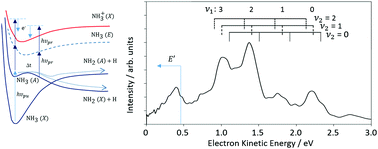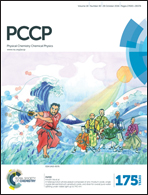Resonant multiphoton ionisation probe of the photodissociation dynamics of ammonia
Abstract
The dissociation dynamics of the Ã-state of ammonia have been studied using a resonant multiphoton ionisation probe in a photoelectron spectroscopy experiment. The use of a resonant intermediate in the multiphoton ionisation process changes the ionisation propensity, allowing access to different ion states when compared with equivalent single photon ionisation experiments. Ionisation through the E′ 1A1′ Rydberg intermediate means we maintain overlap with the ion state for an extended period, allowing us to monitor the excited state population for several hundred femtoseconds. The vibrational states in the photoelectron spectrum show two distinct timescales, 200 fs and 320 fs, that we assign to the non-adiabatic and adiabatic dissociation processes respectively. The different timescales derive from differences in the wavepacket trajectories for the two dissociation pathways that resonantly excite different vibrational states in the intermediate Rydberg state. The timescales are similar to those obtained from time resolved ion kinetic energy release measurements, suggesting we can measure the different trajectories taken out to the region of conical intersection.



 Please wait while we load your content...
Please wait while we load your content...